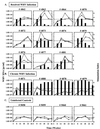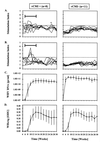Deficiencies in the acute-phase cell-mediated immune response to viral antigens are associated with development of chronic woodchuck hepatitis virus infection following neonatal inoculation
- PMID: 11799172
- PMCID: PMC135887
- DOI: 10.1128/jvi.76.4.1769-1780.2002
Deficiencies in the acute-phase cell-mediated immune response to viral antigens are associated with development of chronic woodchuck hepatitis virus infection following neonatal inoculation
Abstract
In vitro proliferation of peripheral blood mononuclear cells was used to measure virus-specific cell-mediated immunity (vCMI) following neonatal woodchuck hepatitis virus (WHV) infection. Fifteen neonates were inoculated with the W8 strain of WHV. In 11, infection was resolved, and 4 became chronic carriers. Nineteen neonates were inoculated with the W7 strain and all became chronic carriers. Seven age-matched uninfected woodchucks served as controls. Virologic and vCMI profiles among the W8 and W7 infections were compared and related to the outcome of infection. Resolving woodchucks had robust, acute-phase vCMI to WHV antigens (core, surface, and x) and to several nonoverlapping core peptides. The acute-phase vCMI was associated temporally with the clearance of viral DNA and of surface antigen from serum at 14 to 22 weeks postinfection. In contrast, in approximately half of the W8 and W7 infections that progressed to chronicity, no significant acute-phase vCMI was detected. In the remaining carriers, acute-phase vCMI was observed, but it was less frequent and incomplete compared to that of resolved woodchucks. Serum viral load developed less rapidly in those carriers that had evidence of acute-phase vCMI, but it was still increased compared to that of resolving woodchucks. Thus, vigorous and multispecific acute-phase vCMI was associated with resolution of neonatal WHV infection. Absent or incomplete acute-phase vCMI was associated with the progression to chronic infection. By analogy, these results suggest that the onset of chronic hepatitis B virus (HBV) infection in humans may be associated with deficiencies in the primary T-cell response to acute HBV infection.
Figures



Similar articles
-
Acute resolving woodchuck hepatitis virus (WHV) infection is associated with a strong cytotoxic T-lymphocyte response to a single WHV core peptide.J Virol. 2007 Jul;81(13):7156-63. doi: 10.1128/JVI.02711-06. Epub 2007 Apr 25. J Virol. 2007. PMID: 17459928 Free PMC article.
-
Kinetics of viremia and acute liver injury in relation to outcome of neonatal woodchuck hepatitis virus infection.J Med Virol. 2004 Mar;72(3):406-15. doi: 10.1002/jmv.20019. J Med Virol. 2004. PMID: 14748064
-
T-Cell response to woodchuck hepatitis virus (WHV) antigens during acute self-limited WHV infection and convalescence and after viral challenge.J Virol. 1998 Jul;72(7):6083-91. doi: 10.1128/JVI.72.7.6083-6091.1998. J Virol. 1998. PMID: 9621072 Free PMC article.
-
Evaluation of new approaches to prophylactic and therapeutic vaccinations against hepatitis B viruses in the woodchuck model.Intervirology. 2001;44(2-3):124-31. doi: 10.1159/000050039. Intervirology. 2001. PMID: 11509873 Review.
-
The woodchuck as an animal model for pathogenesis and therapy of chronic hepatitis B virus infection.World J Gastroenterol. 2007 Jan 7;13(1):104-24. doi: 10.3748/wjg.v13.i1.104. World J Gastroenterol. 2007. PMID: 17206759 Free PMC article. Review.
Cited by
-
Advantages to the use of rodent hepadnavirus core proteins as vaccine platforms.Vaccine. 2007 Feb 19;25(9):1593-606. doi: 10.1016/j.vaccine.2006.11.013. Epub 2006 Nov 17. Vaccine. 2007. PMID: 17178179 Free PMC article.
-
Acute resolving woodchuck hepatitis virus (WHV) infection is associated with a strong cytotoxic T-lymphocyte response to a single WHV core peptide.J Virol. 2007 Jul;81(13):7156-63. doi: 10.1128/JVI.02711-06. Epub 2007 Apr 25. J Virol. 2007. PMID: 17459928 Free PMC article.
-
Therapeutic vaccination in chronic hepatitis B: preclinical studies in the woodchuck.Hepat Res Treat. 2010;2010:817580. doi: 10.1155/2010/817580. Epub 2010 Sep 7. Hepat Res Treat. 2010. PMID: 21188201 Free PMC article.
-
The Woodchuck, a Nonprimate Model for Immunopathogenesis and Therapeutic Immunomodulation in Chronic Hepatitis B Virus Infection.Cold Spring Harb Perspect Med. 2015 Oct 28;5(12):a021451. doi: 10.1101/cshperspect.a021451. Cold Spring Harb Perspect Med. 2015. PMID: 26511761 Free PMC article. Review.
-
Immunization with surface antigen vaccine alone and after treatment with 1-(2-fluoro-5-methyl-beta-L-arabinofuranosyl)-uracil (L-FMAU) breaks humoral and cell-mediated immune tolerance in chronic woodchuck hepatitis virus infection.J Virol. 2002 Jun;76(11):5305-14. doi: 10.1128/jvi.76.11.5305-5314.2002. J Virol. 2002. PMID: 11991959 Free PMC article.
References
-
- Bertoletti, A., A. Sette, F. V. Chisari, A. Penna, M. Levrero, M. De Carli, F. Fiaccadori, and C. Ferrari. 1994. Natural variants of cytotoxic epitopes are T-cell receptor antagonists for antiviral cytotoxic T-cells. Nature (London) 369:407-410. - PubMed
-
- Chang, K. M., and F. V. Chisari. 1999. Immunopathogenesis of hepatitis B virus infection. Clin. Liver Dis. 3:221-239. - PubMed
-
- Chisari, F. V., and C. Ferrari. 1997. Viral hepatitis, p. 745-778. In N. Nathanson (ed.), Viral pathogenesis, Lippincott-Raven Publisher, Philadelphia, Pa.
-
- Cohen, J. I., R. H. Miller, B. Rosenblum, K. Denniston, J. L. Gerin, and R. H. Purcell. 1988. Sequence comparison of woodchuck hepatitis virus replicative forms shows conservation of the genome. Virology 182:12-20. - PubMed
-
- Cote, P. J., B. E. Korba, R. H. Miller, J. R. Jacob, B. H. Baldwin, W. E. Hornbuckle, R. H. Purcell, B. C. Tennant, and J. L. Gerin. 2000. Effects of age and viral determinants on chronicity as an outcome of experimental woodchuck hepatitis virus infection. Hepatology 31:190-200. - PubMed
Publication types
MeSH terms
Substances
Grants and funding
LinkOut - more resources
Full Text Sources
Medical

